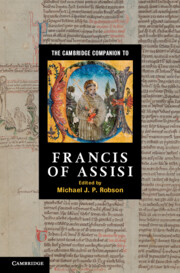Book contents
- Frontmatter
- Introduction
- PART I Francis of Assisi
- 1 Francis and the Franciscan movement (1181/2–1226)
- 2 The writings of Francis
- 3 The Rule and life of the Friars Minor
- 4 Francis and his hagiographical tradition
- 5 Voluntary simplicity: the attitude of Francis towards learning in the early biographies
- 6 Francis and the historiographical tradition in the order
- 7 Francis and Clare and the emergence of the Second Order
- 8 Francis and the encounter with the sultan (1219)
- 9 Francis and creation
- PART II The heritage of Francis of Assisi
- Index
7 - Francis and Clare and the emergence of the Second Order
from PART I - Francis of Assisi
Published online by Cambridge University Press: 28 November 2011
- Frontmatter
- Introduction
- PART I Francis of Assisi
- 1 Francis and the Franciscan movement (1181/2–1226)
- 2 The writings of Francis
- 3 The Rule and life of the Friars Minor
- 4 Francis and his hagiographical tradition
- 5 Voluntary simplicity: the attitude of Francis towards learning in the early biographies
- 6 Francis and the historiographical tradition in the order
- 7 Francis and Clare and the emergence of the Second Order
- 8 Francis and the encounter with the sultan (1219)
- 9 Francis and creation
- PART II The heritage of Francis of Assisi
- Index
Summary
FRANCIS AND CLARE, THE MERCHANT AND THE LADY
Francis seemed to be surprised when other men asked to join him. But he welcomed those who came, and soon an evangelical fraternity was born. In 1209, when, according to the hagiographers, they had reached the symbolic number of twelve, Francis and his brothers went to Rome to seek papal confirmation of their form of living. Eventually they returned to Assisi, having been blessed by Innocent III. Did Francis consider the possibility of women joining his group? There is clearly no mention of a female presence on the journey to Rome. In the context of the time, it would certainly have created problems for unmarried men and women, especially from different social classes, to travel on the road together. It is quite unlikely that such a group would have been viewed positively in Rome, much less that it would have received the blessing of the pope. And yet some sources – including the Testament of Clare of Assisi herself – mention that before Francis had any brothers, while he was working on the restoration of the little church of San Damiano outside Assisi, he used to call out to people in French, talking about the coming of holy women to that holy place:
While labouring with others in that work, he used to clamour to people living as well as passing by the church in a loud voice, filled with joy of the spirit, telling them in French: ‘Come and help me in the work of the church of San Damiano which, in the future, will be a monastery of ladies through whose fame and life our heavenly Father will be glorified throughout the church.’
The use of the word lady puts the story in the medieval context of chivalry and nobility, the social class that Francis, wealthy but only a merchant, had been longing to become part of.
- Type
- Chapter
- Information
- The Cambridge Companion to Francis of Assisi , pp. 115 - 126Publisher: Cambridge University PressPrint publication year: 2011



